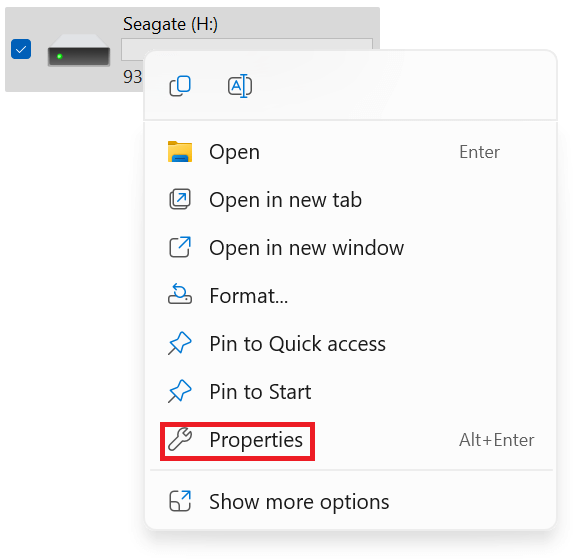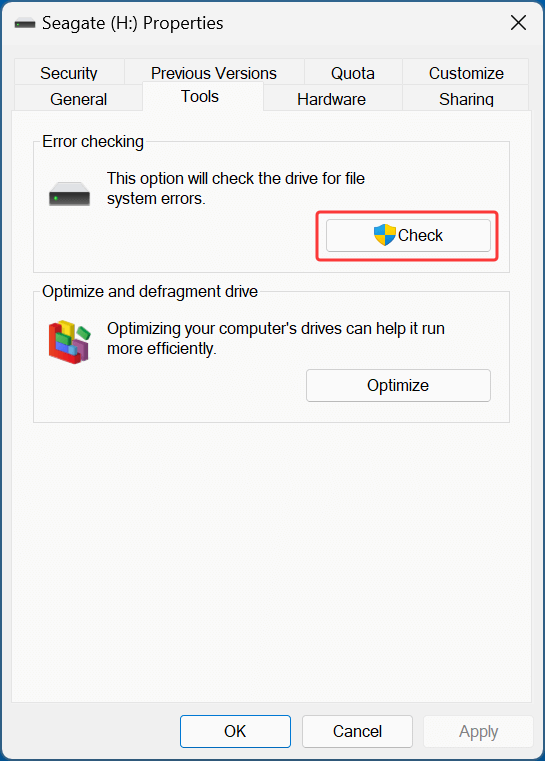Tip: Before fixing corrupted NTFS file system, you can use data recovery software - such as Donemax Data Recovery to export or recover all files from the NTFS drive to another drive to prevent data loss. Data recovery software can deeply scan the inaccessible or formatted NTFS drive and find all recoverable files.
PAGE CONTENT:
NTFS (New Technology File System) is the default file system for modern versions of Windows. It is designed to support large files, improve reliability, and maintain file security using permissions and encryption. However, like all storage formats, NTFS can suffer from corruption, logical errors, and drive failures.
Whether your NTFS drive is showing up as RAW, inaccessible, or is prompting you to format it - this guide covers how to repair NTFS drives and fix common NTFS file system errors using built-in Windows tools, third-party utilities, and data recovery solutions.
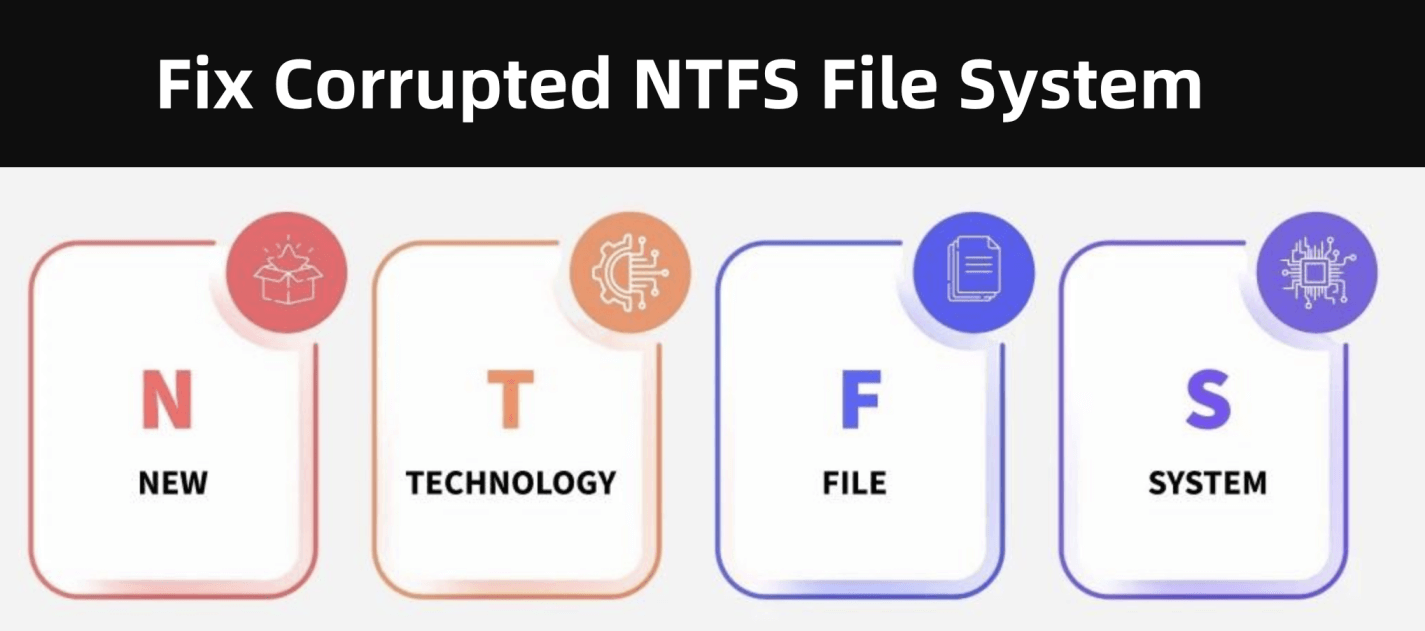
"Hi, about two days ago I used a system drive from one PC on another PC to store some important data on one of its partitions. This drive was then chkdsk'd by the Windows install on it when I plugged it back into the original PC, which then somehow corrupted the NTFS partition I copied my files to. This partition was freshly formatted, so chkdsk wanting to check it came as a surprise to me..." - Anonymous from Microsoft Forum
Many users have encountered the issue "NTFS drive gets corrupted." Let's see why it will happen and how to fix common NTFS issues.
Why A NTFS Drive Gets Corrupted?
1. Symptoms of NTFS File System Errors
If your NTFS drive is experiencing errors, you might encounter symptoms such as:
- The drive becomes unreadable or inaccessible in File Explorer.
- Windows prompts: "You need to format the disk before you can use it."
- File system listed as RAW instead of NTFS.
- Unexpected slowness or inability to open files.
- Error messages like "The file or directory is corrupted and unreadable."
- CHKDSK runs at every startup or triggers error scanning prompts.
Recognizing these symptoms early allows for timely action before permanent data loss occurs.
2. Common Causes of NTFS Drive Errors
NTFS errors typically arise due to:
- Sudden power failure or improper ejection of external drives.
- Bad sectors on hard disks or SSDs.
- Malware, ransomware, or rootkits damaging file system structures.
- System crashes or improper shutdowns.
- File table corruption due to faulty software or interrupted writes.
- Aging or degrading storage media.
Understanding the cause can help determine the right repair method.
3. Preliminary Steps Before Repair
Before attempting any NTFS repair, follow these safety steps:
Step 1: Back Up the Data (If Accessible)
If your files are still visible, copy them to a safe location. Even partial access is better than risking full data loss during a repair attempt.
Step 2: Check Physical Connections
Make sure the drive is properly connected. Try switching USB ports or cables if it's an external drive.
Step 3: Run a Malware Scan
Use a reliable antivirus program to scan the drive. Some malware types can cause NTFS corruption.
Recover or Export Files Before Fixing Corrupted NTFS Drive
Before fixing damaged or corrupted NTFS drives, you can use data recovery software - such as Donemax Data Recovery to completely recover deleted, formatted or inaccessible files from them.
Step 1. Download and install Donemax Data Recovery on your computer and ensure the NTFS drive is connected to the same computer.
Step 2. Open Donemax Data Recover and select the corrupted NTFS drive to start data recovery.
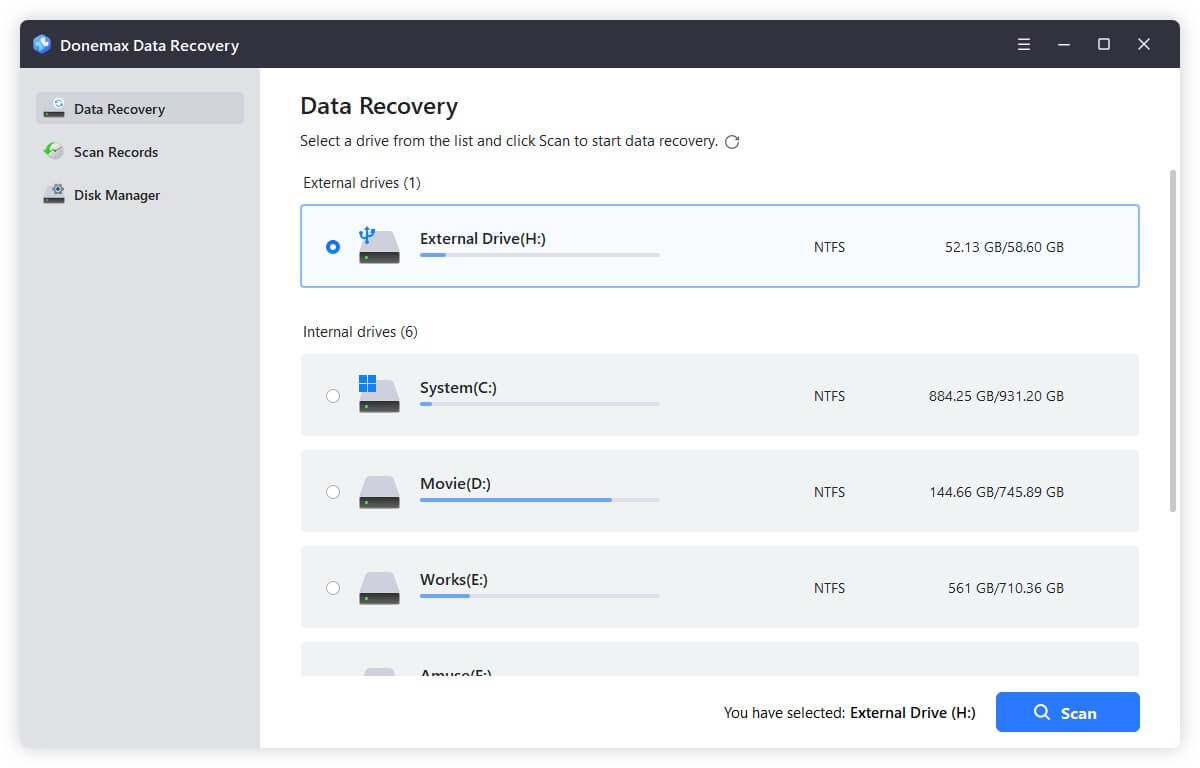
Step 3. Click on Scan button. Then this powerful data recovery tool will deeply scan the NTFS drive and find all recoverable files.
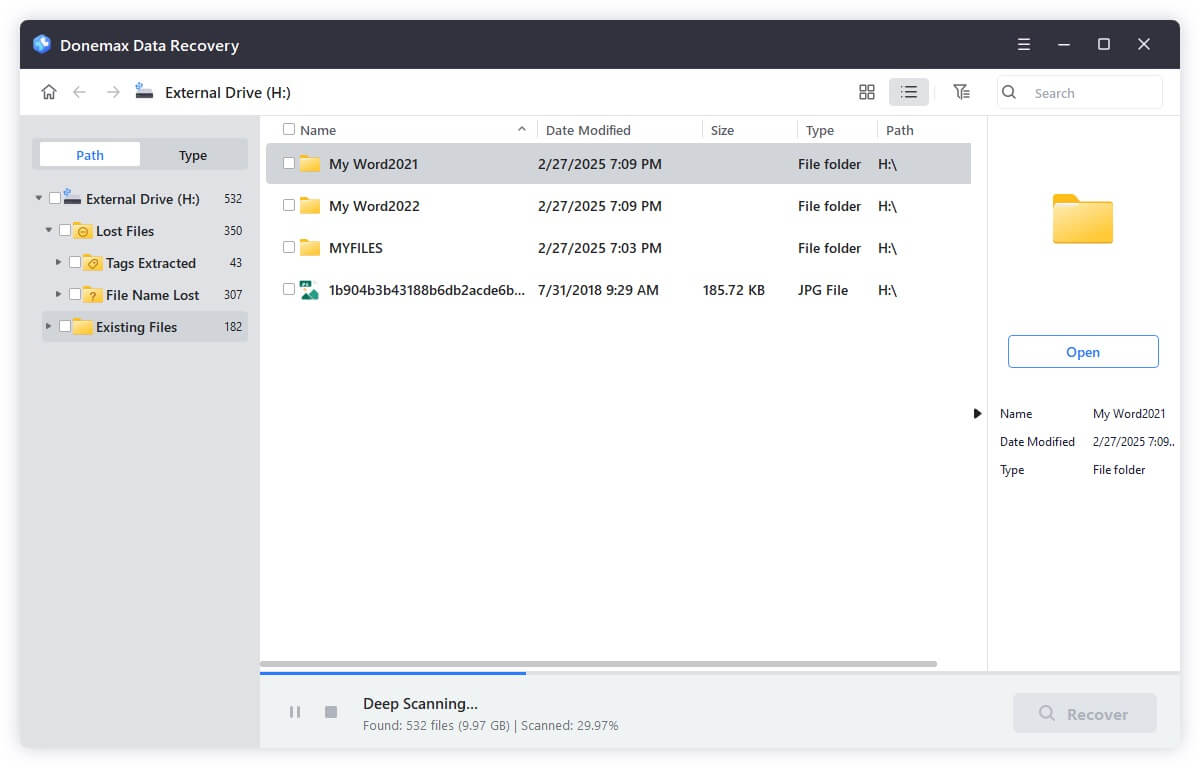
Step 4. After scanning, it lists all recoverable files. Just select the wanted files, click on Recover button to save them to a safe location - not the corrupted NTFS drive.
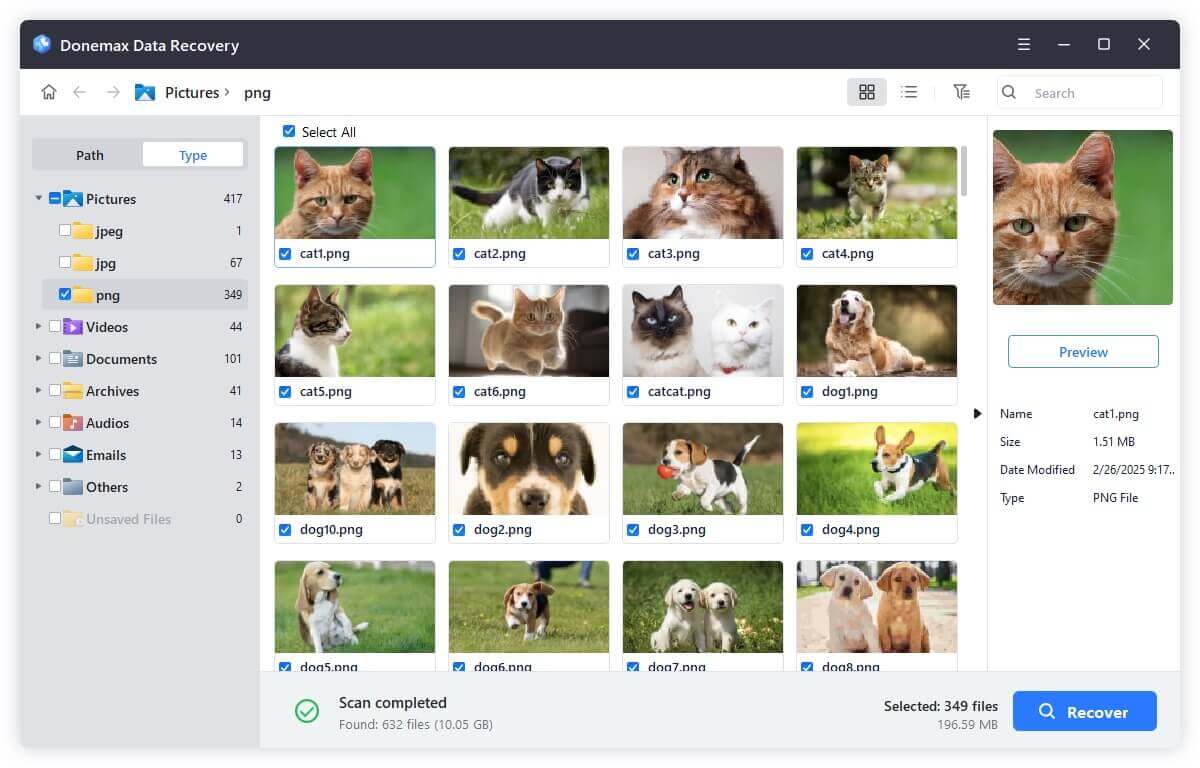
How to Repair NTFS Drives and Fix Errors? [5 Methods]
Let's walk through the most effective repair methods for fixing NTFS file system issues.
Method 1. Repair NTFS Drive Using CHKDSK (Check Disk Utility)
CHKDSK (Check Disk) is a built-in Windows utility designed to scan file systems and volumes for logical and physical errors. It's one of the most powerful tools for repairing NTFS drives that are showing signs of corruption, bad sectors, or directory inconsistencies.
When to Use CHKDSK
You should run CHKDSK if:
- You encounter "The file or directory is corrupted and unreadable."
- The drive is slow to respond or access files.
- File Explorer crashes when opening a folder on that drive.
- Windows requests a scan every time you boot.
- The drive was improperly removed or experienced a sudden power loss.
How to Use CHKDSK:
- Type cmd into the Command Prompt, right-click it, and choose Run as administrator.
- Type the following command:
chkdsk X: /f /r /x
Replace X: with your actual drive letter.
Explanation of Flags:
- /f – Fixes file system errors.
- /r – Locates bad sectors and recovers readable data.
- /x – Forces dismounting the drive before scan.
Pros
- Built-in, free, and effective for most logical errors.
Cons
- May take hours on large or badly corrupted drives.
- Can cause further issues if interrupted.
Example Use Case
Let's say your external NTFS drive (E:) was unplugged improperly and now shows this error:
"You need to format the disk in drive E: before you can use it."
Instead of formatting (which erases data), run:
chkdsk E: /f /r /x
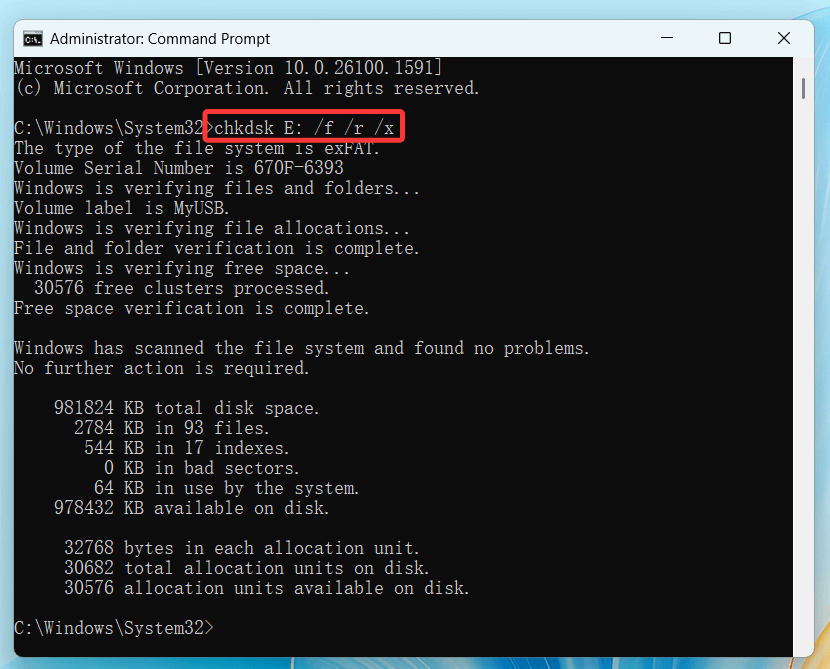
This command will:
- Dismount the drive.
- Scan and fix file system errors.
- Locate and mark bad sectors to prevent future data storage there.
After the scan:
- If successful, the drive may become accessible again.
- If not, proceed with data recovery tools before formatting.
Common CHKDSK Messages and What They Mean
- "Windows has made corrections to the file system."
Repair was successful.
- "The volume is in use by another process. Would you like to schedule this volume to be checked the next time the system restarts?"
Type Y to schedule a boot-time check for system drives (like C:).
- "CHKDSK cannot run on a RAW drive."
The file system is damaged beyond NTFS recognition. You'll need to recover data first using software like Donemax Data Recovery.
💡 Tips When Using CHKDSK
- Do not interrupt the CHKDSK process, especially with /r flag - it could take hours but halting it may corrupt data further.
- Use /scan on newer systems for a less intrusive analysis:
chkdsk X: /scan
- Avoid running CHKDSK frequently on SSDs with /r since excessive read-write cycles can reduce lifespan.
❓ Where CHKDSK Stores Logs
You can view the log of CHKDSK in Event Viewer:
- Press Win + X > Event Viewer
- Move to: Application from Windows Logs
- Filter by source: Wininit to find boot-time CHKDSK logs.
Method 2. Repair NTFS Drive with Windows Error Checking Tool
For those who find command-line tools unsettling:
- Open File Explorer, right-click the problematic drive.
- Go to Properties > Tools.
![repair NTFS drives]()
- Under "Error Checking," click Check.
![repair NTFS drives]()
- Let Windows scan and repair the volume.
This tool performs a similar function to CHKDSK but through a graphical interface.
Method 3. Repair NTFS File System Using PowerShell Repair Commands
PowerShell provides an alternative for disk repair in modern Windows versions.
Steps:
- Select Windows PowerShell (Admin) with a right-click on Start.
- Run:
Repair-Volume -DriveLetter X -Scan
![repair NTFS drives]()
- To automatically repair issues, run:
Repair-Volume -DriveLetter X -OfflineScanAndFix
![repair NTFS drives]()
(Replace X with the actual drive letter of the NTFS drive.)
Advantages:
- Simple syntax and modern interface.
- Works on both internal and external NTFS drives.
Method 4. Fix Corrupted NTFS Drive Using Third-Party NTFS Repair Tools
If built-in methods fail, third-party software can help.
Recommended Tools:
- Donemax Data Recovery
- MiniTool Partition Wizard
- AOMEI Partition Assistant
Features:
- Scan for partition errors.
- Fix MBR and partition table issues.
- Rebuild file system structures.
For example. You can use Donemax Data Recovery to repair any NTFS drive on Windows and macOS. Just choose Disk Manager, select the corrupted NTFS drive, click on Repair button to start finding and fixing logical errors.

Method 5. Advanced NTFS Repair Techniques
In severe cases, deeper troubleshooting is required.
1. Fix RAW NTFS Drive
If your NTFS partition appears as RAW:
Step-by-Step:
- Open Disk Management: Win + X > Disk Management
- Check if the partition is healthy or unallocated.
- If listed as RAW, do not format it yet.
- Use chkdsk or testdisk to try and recover the partition.
CMD Option:
chkdsk X: /f
If it returns an error saying “The type of the file system is RAW,” proceed to recovery before repair.
2. Repair NTFS via Windows Installation Media
If Windows fails to boot due to NTFS errors:
- Boot from a Windows installation USB.
- Select Command Prompt from Troubleshoot via Repair your computer > >.
- Use these commands:
bootrec /fixmbr
bootrec /fixboot
chkdsk C: /f /r
sfc /scannow
This method is essential for system drives that prevent boot-up.
3. Rebuild or Recover NTFS Partitions
If the partition itself is missing or corrupted:
- Use tools like TestDisk or Partition Find and Mount.
- These tools can detect lost NTFS volumes and rebuild the partition table.
This is particularly useful if the drive shows as unallocated or the NTFS signature is lost.
When to Seek Professional Help?
If:
- The drive makes clicking or grinding noises.
- All DIY recovery tools fail to detect the drive.
- CHKDSK or third-party repair tools cannot proceed.
Then you may be facing physical drive damage. In such cases, do not attempt more repairs, as they can cause irreversible damage.
Instead, contact a professional data recovery service that operates in a cleanroom environment.
Prevent Future NTFS File System Errors
Once repaired, ensure long-term stability with these tips:
🔹 Safely Eject External Drives
Never unplug USB or external HDDs without ejecting them via the taskbar.
🔹 Avoid Forced Shutdowns
Improper shutdowns can corrupt the NTFS metadata.
🔹 Use a UPS (Uninterruptible Power Supply)
Helps avoid data loss due to sudden power failure.
🔹 Monitor Drive Health
Use S.M.A.R.T. tools (like CrystalDiskInfo) to track disk health and potential failures.
🔹 Regular Disk Checks
Run chkdsk periodically or use Windows Task Scheduler to automate checks.
🔹 Defragment HDDs (not SSDs)
Fragmentation increases read/write stress and can lead to logical errors. Use built-in defragmentation tools.
Conclusion
NTFS file system errors are common but usually fixable with the right tools and techniques. From built-in utilities like CHKDSK and PowerShell to more advanced tools and recovery software, there are multiple ways to bring your NTFS drive back to life.
Key Takeaways:
- Act quickly when signs of NTFS corruption appear.
- Backup first, then proceed with repairs.
- Use CHKDSK or PowerShell for quick fixes.
- Consider data recovery before formatting or rebuilding.
- Adopt preventive measures to reduce future risks.
With patience and the right steps, you can restore a corrupted NTFS drive without data loss or system reinstallation.


Donemax Data Recovery
One of the best data recovery programs to recover deleted, formatted or lost data from PC, Mac, HDD, SSD, USB drive, SD card, camera, RAID, Sever or other storage devices.
Related Articles
- Nov 21, 2024(Solved) Can't Change Permissions on External Drive on Mac
- Feb 17, 2025External Hard Drive Freezes My Computer: How to Fix This Issue
- Feb 22, 2025How to Fix Corrupted XQD Card Without Losing Data?
- Dec 24, 2024Fix MacBook Bluetooth Won't Turn On
- Jun 02, 2024Fix Your PC Ran Into A Problem and Needs to Restart
- Dec 08, 2025PC BIOS Corruption: Error Messages & Solutions

Steven
Steven has been a senior writer & editor of Donemax software since 2020. He's a super nerd and can't imagine the life without a computer. Over 6 years of experience of writing technical solutions and software tesing, he is passionate about providing solutions and tips for Windows and Mac users.

Gerhard Chou
In order to effectively solve the problems for our customers, every article and troubleshooting solution published on our website has been strictly tested and practiced. Our editors love researching and using computers and testing software, and are willing to help computer users with their problems
Hot Donemax Products
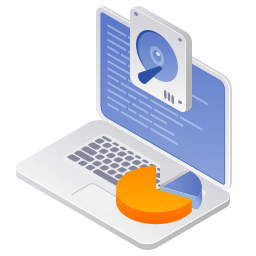
Clone hard drive with advanced clone technology or create bootable clone for Windows/Mac OS.
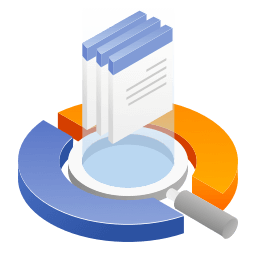
Completely and easily recover deleted, formatted, hidden or lost files from hard drive and external storage device.

Certified data erasure software - permanently erase data before selling or donating your disk or any digital device.
